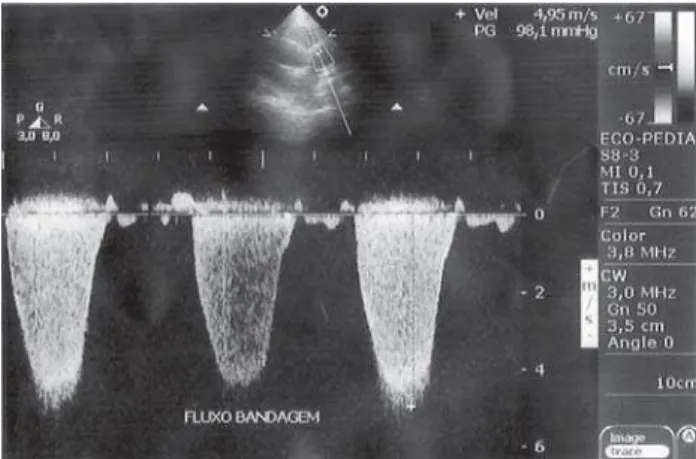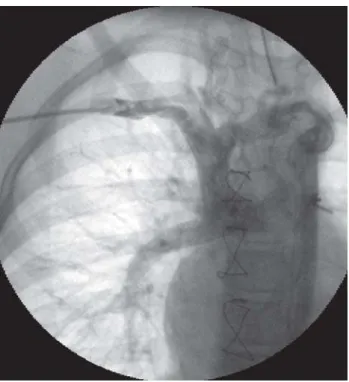94
1. São José do Rio Preto Pediatric Cardiovascular Surgery Service – Hospital de Base – São José do Rio Preto Medical School – São José do Rio Preto, SP.
Ulisses Alexandre CROTI1, Domingo Marcolino BRAILE1, Moacir Fernandes de GODOY1, Fabiana Nakamura
AVONA1
Rev Bras Cir Cardiovasc 2009; 24(1): 94-97 CLINICAL-SURGICAL CORRELATION
RBCCV 44205-1060
Glenn bidirecional com cianose precoce por conexão veno-venosa pela veia hemiázigo
Early cyanosis after bidirectional glenn operation
by venovenous connection via hemiazygos vein
Correspondence address: Ulisses Alexandre Croti
Hospital de Base – FAMERP – Avenida Brigadeiro Faria Lima, 5544 – São José do Rio Preto, SP, Brasil – CEP 15090-000
Phone (Fax): (17) 3201-5025/3222-6450/ 9772-6560 E-mail address: uacroti@uol.com.br
Article received on February 20th, 2009 Article accepted on March 12nd, 2008 CLINICAL DATA
6 year-five-month-girl, 15 kg, from Comodoro, MT. Full-term patient, presented fatigue and cyanosis presentation at 3 months of life and underwent banding of the pulmonary trunk (BPT) through left thoracotomy in another Service at 8 months. The mother reports that after surgery there was an improvement of dyspnea, but not of cyanosis and weight gain.
Due to difficulties found by the patient at the Unified Health System (SUS) [1], she was referred to our Service with 3 years and 6 months of life. Thus, tricuspid atresia with concordant ventriculoarterial connection, restrictive interventricular communication, foramen ovale interatrial communication and effective BPT were diagnosed.
Following our protocol for referring patients with univentricular physiology in different surgical stages (Glenn and Fontan), bidirectional Glenn operation (superior bidirectional cavopulmonary) was performed with connection between the superior vena cava (SVC) and right pulmonary artery (RPA), ligation and section of the azygous vein, resection of the interatrial septum and new and more tight BPT, allowing small anterograde flow and a pulmonary artery pressure less than 15 mmHg. The patient was
discharged from hospital on the seventh postoperative day using aspirin and with peripheral saturation of 92%.
After 1 year and 6 months, the mother reported again important patient’s cyanotic episodes. At the time, the peripheral saturation at rest was 84%, with indication of echocardiography with injection of microbubbles for detection of arteriovenous or venovenous connections that could cause such very severe unsaturation. Contrast in right upper limb (RUL) was injected, which moved through the right atrium (RA) from the inferior vena cava (IVC), suggesting the presence of flow between the innominate vein and IVC. The connection of the SVC to RPA in bidirectional Glenn operation presented excellent flow and the tight BPT was effective.
Thus, hemodynamic study was indicated for accurate assessment of the anatomy and pressure in the pulmonary artery, but due to personal and Brazilian geographical difficulties, the mother returned only after almost two years, when the child presented a significant worsening of cyanosis and peripheral saturation of 76% at rest.
95
CROTI, UA ET AL - Early cyanosis after bidirectional glenn operation by venovenous connection via hemiazygos vein
Rev Bras Cir Cardiovasc 2009; 24(1): 94-97
single second heart sound and high left sternal border and systolic murmur +++/4+ in the left middle sternal border. Pulmonary auscultation was normal. Flaccid abdomen, plan, without visceromegalies. Palpable and symmetrical pulses in the four limbs and digital clubbing.
Still regarding the patient’s previous history, an important fact was a brain abscess drained and without sequelae at 2 years and 6 months.
ELECTROCARDIOGRAM AND HOLTER MONITORING
Low right atrial rhythm, rate of 75 beats/min, SÂP -30º, SÂQRS -60°, PR 120ms, QRS 120ms. Anterosuperior division of de left bundle branch block (Figure 1).
The Holter, routinely performed prior to total cavopulmonary operation, indicated low atrial rhythm with a left anteroposterior fascicular block and heart rate of 70 bpm. Low right atrial rhythm with mean heart rate of 85 bpm: the minimum rate was of 54 bpm at 00:27 and the maximum of 143 bpm at 12:24. Presence of isolated right atrial ectopic beats. Absence of symptoms recorded on the log.
Fig. 1 - Electrocardiogram prior to Fontan-type operation (total cavopulmonary) with low right atrial rhythm and anterosuperior division of de left bundle branch block
Fig. 2 – Trace of pulsed Doppler with sample at the anastomosis between the superior vena cava and right pulmonary artery with a peak velocity of 0.34 m/s
Fig. 3 – Trace of continuous Doppler showing systolic gradient by banding of the pulmonary trunk of 98mmHg
and RPA and without stenosis (Figure 2), large interatrial communication of 18 mm by resection of the interatrial septum, restrictive interventricular communication of 2 mm, effective BPT with peak Doppler gradient of 98 mmHg (Figure 3) in addition to the confirmed diagnosis of venovenous connection with the injection of saline solution in RUL that reached the RA came from the IVC.
The hemodynamic study clearly identified the cause of unsaturation. The right subclavian venography showed that the SVC was connected directly to the RPA, with filling of the entire pulmonary arterial system. There was also the major drainage of the innominate vein in retrograde direction to the hemiazygos vein, which drained posteriorly in the IVC system (Figures 4 to 6). The mean pressure in the pulmonary artery was 13 mmHg.
RADIOGRAM
Visceral situs solitus in levocardia. Increased cardiac area with a cardiothoracic index of 0.58. Thoracic skeleton with preserved aspect. Prominence of the pulmonary vascular network with unchanged parenchyma and free diaphragmatic domes.
96
DIAGNOSIS
The significant unsaturation occurred prior to the bidirectional Glenn operation is not rare, but it is uncommon and its cause must be thoroughly investigated by the medical team.
The hemodynamic study should always be sought and commonly performed when anomalous connections that may be embolized or surgically connected [2] are found.
In our patient, the social condition, age and anterograde flow - purposely left in the bidirectional Glenn operation, were key factors for the indication of Fontan-type operation rather than the ligation of the hemiazygos vein, which has developed impressively and anomalously [3 ].
OPERATION
The Fontan or total cavopulmonary (with extracardiac tube) operation was performed as usually described by our team in previous articles [4,5,6]. There was no fenestration of the tube to the RA.
It began with transsternal median thoracotomy, dissection of severe adhesions - especially in the RA. Heparinization, installation of conventional circuit of cardiopulmonary bypass using cannulas in the aorta and vena cava - as distal as possible from the heart. Deep hypothermia at 18°C, aortic clamping, opening of the RA for aspiration, single anterograde hypothermic blood cardioplegia at 4ºC. Total circulatory arrest. Section of the pulmonary trunk and suture of the extremities using 4-0 and 5-0 polypropylene wire. The RPA was opened as central Fig. 4 - Injection of contrast in right subclavian vein showing the
superior vena cava connected to the pulmonary artery system. There is also the filling of the innominate vein with major drainage in retrograde direction through the hemiazygos vein to the inferior vena cava
Fig. 5 - Innominate vein catheter showing retrograde flow of contrast in hemiazygos vein into the inferior vena cava system
Fig. 6 - Hemiazygos vein catheter showing contrast of its drainage to inferior vena cava system and return to the right atrium
CROTI, UA ET AL - Early cyanosis after bidirectional glenn operation by venovenous connection via hemiazygos vein
97 REFERENCES
1. Pinto Júnior VC, Daher CV, Sallum FS, Jatene MB, Croti UA. Situação das cirurgias cardíacas congênitas no Brasil. Rev Bras Cir Cardiovasc. 2004;19(2):III-VI.
as possible in the lower face, and a 20mm Hemashild tube was anastomosed to it using a 6-0 polypropylene wire. The other tube extremity was anastomosed (end-to-end) using a 5-0 polypropylene wire to the IVC, which was sectioned in the RA. The perfusion time was 112 minutes, myocardial ischemia and total cardiac arrest of 58 minutes.
In the Intensive Care Unit the patient presented right pleural effusion for 11 days, progressing satisfactorily and was discharged from hospital in good clinical conditions at the 16th postoperative day with peripheral saturation of 96% and using oral anticoagulants.
2. Payne RM, Bensky AS, Hines MH. Division of venous collateral after Glenn shunt by minimally invasive surgery. Ann Thorac Surg. 2000;70(3):973-5.
3. Calvaruso DF, Rubino A, Ocello S, Salviato N, Guardi D, Petruccelli DF, et al. Bidirectional Glenn and antegrade pulmonary blood flow: temporary or definitive palliation? Ann Thorac Surg. 2008;85(4):1389-96.
4. Croti UA, Braile DM, Moscadini AC, Godoy MF. Cavopulmonar total extracardíaco com tubo de pericárdio bovino corrugado sem auxílio de circulação extracorpórea. Rev Bras Cir Cardiovasc. 2005;20(3):346-7.
5. Croti UA, Braile DM, Sobrinho SH, De Marchi CH. Cavopulmonar total extracardíaco com homoenxerto criopreservado. Rev Bras Cir Cardiovasc. 2005;20(3):348-9.
6. Croti UA, Braile DM. Cavopulmonar total extracardíaco sem circulação sem auxílio de circulação extracorpórea. Rev Bras Cir Cardiovasc. 2008;23(3):429-30.
CROTI, UA ET AL - Early cyanosis after bidirectional glenn operation by venovenous connection via hemiazygos vein

